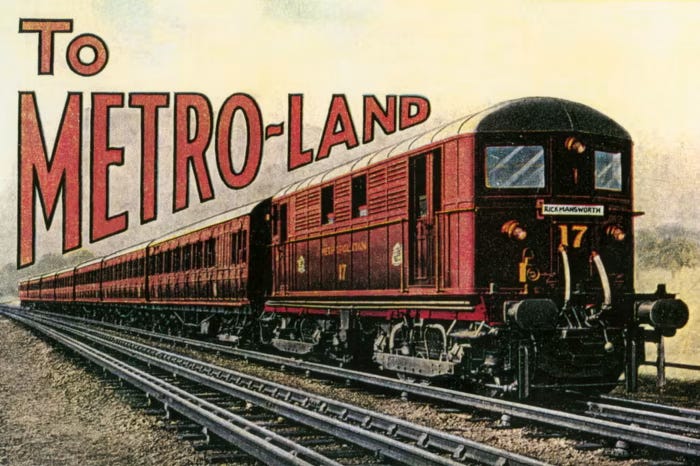Tracks and Tracts
How to build more infrastructure and homes together with one quick fix
The Metropolitan Line of the London Underground is a testament to Britain’s pioneering spirit. It first opened in 1863, a full three decades before any other city opened an underground metro (a word that originally derives from the Metropolitan Railway itself). But being the first underground railway to open is not the only area that the Metropolitan Railway innovated.
From the 1880s through 1933, the Metropolitan Railway commercially acquired and developed land near its railway lines. Over the inter-war period, the developments were famously known as Metro-land. The railway would buy up tracts of farmland to the north-west of built up London. Then the company would build a railway extension through the land, which would greatly increase its value. The land could then be sold by a sister company of the railway at a profit to develop into new homes and suburbs. Metro-land was an innovative shift, where instead of just relying on fares from existing towns to make a profit, the Metropolitan Railway focused on selling land and creating new demand.
The London suburbs of Harrow, Brent, Wembley, and even Amersham owe their existence to this development. Yet this development was only possible because of a legal peculiarity that the Metropolitan Railway had that other railway companies lacked. The Met was able to retain land that may be of future use for the railway. Its sister company could then develop the land. This legal quirk allowed for the development of many beloved suburbs, tens of thousands of new homes, which in turn helped support dozens of miles of track that we still rely on today. The amalgamation of the Metropolitan Railway into the London Passenger Transport Board (an early predecessor to TfL) led to the end of this legal quirk and explicitly linking new railways and homes.
Yet other countries have taken this forward with great success. Tokyo for example has private railway companies that have built new lines into the countryside funded by the construction of new homes and commercial space alongside the line. The Tokyu Den-en-toshi Line, which translates to Garden City Line, was built into undeveloped land to the south-west of Tokyo. The area around each new station was simultaneously developed into housing, retail, and commercial hubs. Profits from rising land values and property sales helped fund the rail infrastructure, creating a self-sustaining model of transit-oriented development that delivered both transport and housing. Japan continues to use railway corridor development to fund a lot of its new infrastructure.
Britain too could return to better linking up new housing and infrastructure and there’s even an existing piece of legislation that would enable it. The Housing and Planning Act 2016 included measures to link the planning of nationally significant infrastructure projects (NSIPs) with housing. Yet this power was limited by ministerial guidance to just 500 homes. Given the relatively low number of homes, this power has only been used once. Within its 359,866 page planning application, the Lower Thames Crossing has used this power to include provisions to relocate a traveler’s site in Thurrock.
There is nothing stopping the Housing Secretary from issuing ministerial guidance to scrap the 500 home limit. This would enable new large infrastructure to be delivered alongside homes. In turn the sale of these homes could help fund the provision of the infrastructure. One common complaint about new homes is that they’re provided without any of the supporting infrastructure. Scrapping the 500 home limit would explicitly deliver infrastructure alongside any new homes.
One project that will be working its way through the NSIP process soon is East West Rail’s segment to connect Bedford and Cambridge, which will complete the new railway line from Oxford to Cambridge. The Benefit Cost Ratio of this line was always low, but the strategic case of unlocking more homes close to the highly productive cities of Oxford, Cambridge, and Milton Keynes made the project worth doing.
But the line’s estimated £6bn cost is not cheap, especially when there are so many other pressing infrastructure challenges around the country. With the average cost of homes near Cambridge being almost double the cost of construction, there’s a potential uplift of £235,000 per home built. Letting East West Rail purchase land near its stations, build the railway, and then sell the much more valuable land could help fund the railway while also contributing towards the Government’s target of 1.5 million homes. Every 1,000 homes delivered through this mechanism could potentially result in nearly a quarter of a billion pounds that can be used to construct the railway.
Scrapping the 500 home limit could even be a way of delivering new homes near Tempsford and Camborne, where the new railway line will deliver a once-in-a-generation opportunity to build new well-connected homes.
The Housing Secretary can amend the ministerial guidance that limits the number of homes to 500 at any point without primary or secondary legislation. Joining up the building of homes and infrastructure has been successful in the past and in other countries today. All that needs to be done is replace this ministerial guidance that artificially restricts houses with one that encourages homes to be built alongside infrastructure projects.1
The updated ministerial guidance should also change the carve-out that stops development on green belt land and instead align the guidance with the Government’s grey belt policy.



Thanks, Ben. It's an excellent publication, and I recommend it strongly to anyone who hasn't read it.
The principle proposed is exactl correct. The delivery is much more complex, given the number of bodies involved. However, a good but smaller example is being moved forward in MetroWest Bath & Wiltshire by the efforts of local MPs. For background see https://www.connectedcities.org/links/metrowest-event-0325